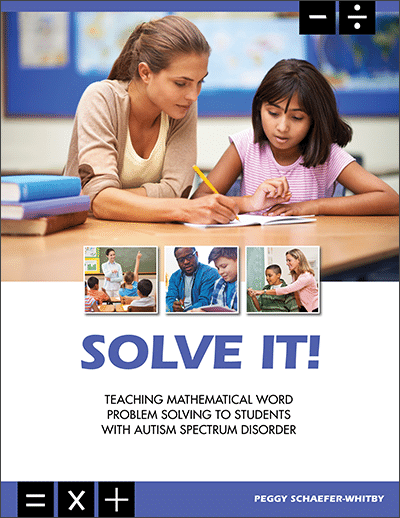
Solve It!

Teaching Mathematical Word Problem Solving to Students with Autism Spectrum Disorder
Author: Peggy Schaefer Whitby
ISBN: 1-931-311-15-3
Printed: $99.00 / #SIM005
Add to CarteBook: $89.00 / #e-SIM005
Add to CartThe purpose of this guide is to provide teachers with what they need to teach students with Autism Spectrum Disorder (ASD) how to solve math word problems using the Solve It! approach. Information in the guide builds on the basic Solve It! instructional approach by focusing on the unique challenges faced by students with ASD when learning how to solve mathematical word problems. Dr. Schaefer Whitby—who studied with Dr. Montague, the original developer of Solve It!—has designed and field-tested instructional accommodations and techniques that support students with ASD in successfully accessing the evidence-based Solve It! approach. Moreover, the instructional accommodations can be integrated seamlessly into inclusive classrooms.
In addition to providing instruction on how to implement the Solve It! approach, the guide helps teachers to:
- Understand the unique learning characteristics that may affect mathematical word problem solving for students with ASD.
- Understand the research that supports the use of Solve It! across disability categories and with students without disabilities.
- Implement the Solve It! approach with students with ASD, including modifying instruction as needed.
- Assess the effectiveness of Solve It! on mathematical word problem solving for students with ASD.
Information in the guide is organized as follows:
- Chapter 1 presents an overview of Solve It!
- Chapter 2 describes the Solve It! instructional components.
- Chapter 3 provides an overview of students with ASD in relation to mathematics and academic achievement.
- Chapter 4 presents the Solve It! strategies to support students with ASD.
- Chapter 5 introduces the Solve It! Scripted Lessons, including instructional materials.
- Chapter 6 presents assessment tools.
- Chapter 7 introduces the role of Booster Lessons.
- Chapter 8 presents strategies for generalization and maintenance of the Solve It!
- The final chapter contains references.
The accompanying Solve It! USB drive contains the instructional materials and directions for printing and duplicating the materials. Files on the USB drive include:
- Video of the author, Dr. Schaefer Whitby, teaching Solve It! to a group of students, including students with ASD.
- Annotated bibliography of selected Solve It!
- Instructional Materials Class Charts
- Student Cue Cards Class Star Chart
- The Rule is … (template)
- Graphic Organizers (for each step)
- Student Activity Sheets
- Scripted Lessons 1–10
- Booster Lesson 1
- Planning Frame
- Multimedia Academic Story (and script)
- Additional 1-, 2-, and 3-Step Problems
- Assessment Mathematical Problem Solving Assessment (Short Form)
- Curriculum-Based Measures
- Student Graph
- Excel application for tracking student progress.
In addition, case studies, featuring three students with ASD—Nick, Claire, and Nate—are included in the guide. Throughout the guide we drop in on, and highlight the work samples of, these three students. The case studies are intended to promote an understanding of the unique challenges students with ASD may encounter when learning to solve math word problems.
Solve It! processes align with the Common Core State Standards (CCSS) (Click to see alignment). Solve It! also aligns with standards in states that have not adopted CCSS (Alaska, Indiana, Minnesota, Nebraska, Oklahoma, Texas , Virginia). Click on the individual state to review alignment.
NOTE: If you purchased the eBook version, you will download a zip file that contains a folder (“Solve It! PDF Files”) which includes the individual files for instructional use that are referenced in the book and a pdf of the Solve It! Autism book.
Read an excerpt of this publication in PDF.
